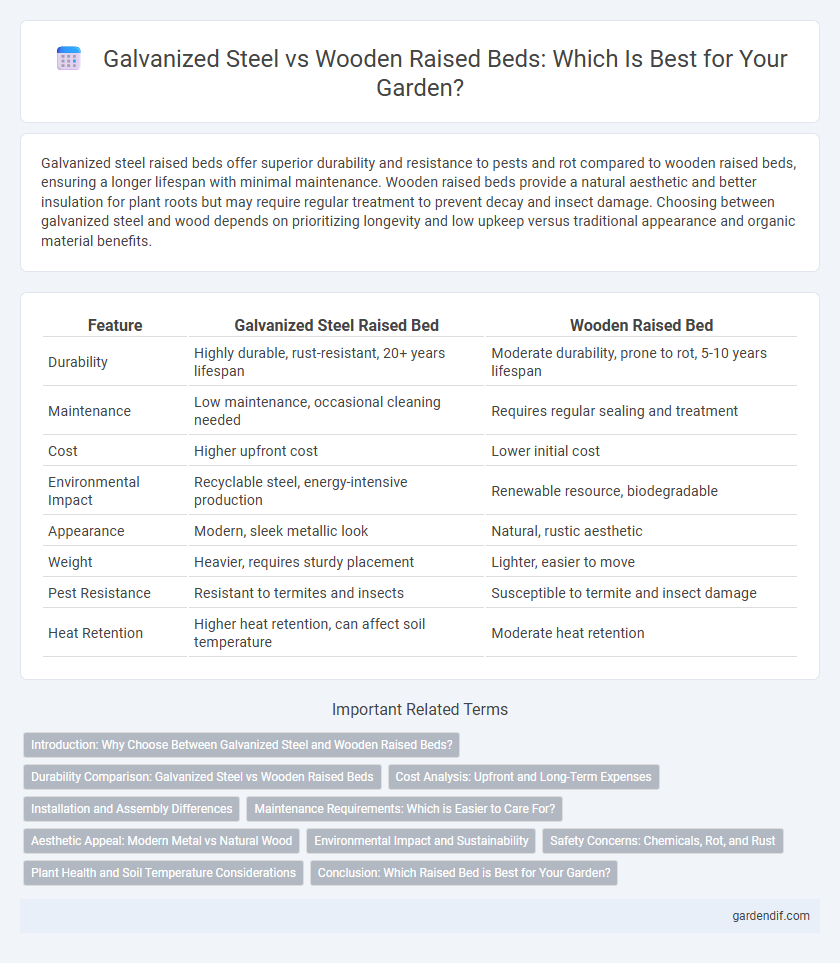
Galvanized Steel vs Wooden Raised Bed Illustration
Galvanized steel raised beds offer superior durability and resistance to pests and rot compared to wooden raised beds, ensuring a longer lifespan with minimal maintenance. Wooden raised beds provide a natural aesthetic and better insulation for plant roots but may require regular treatment to prevent decay and insect damage. Choosing between galvanized steel and wood depends on prioritizing longevity and low upkeep versus traditional appearance and organic material benefits.
Table of Comparison
| Feature | Galvanized Steel Raised Bed | Wooden Raised Bed |
|---|---|---|
| Durability | Highly durable, rust-resistant, 20+ years lifespan | Moderate durability, prone to rot, 5-10 years lifespan |
| Maintenance | Low maintenance, occasional cleaning needed | Requires regular sealing and treatment |
| Cost | Higher upfront cost | Lower initial cost |
| Environmental Impact | Recyclable steel, energy-intensive production | Renewable resource, biodegradable |
| Appearance | Modern, sleek metallic look | Natural, rustic aesthetic |
| Weight | Heavier, requires sturdy placement | Lighter, easier to move |
| Pest Resistance | Resistant to termites and insects | Susceptible to termite and insect damage |
| Heat Retention | Higher heat retention, can affect soil temperature | Moderate heat retention |
Introduction: Why Choose Between Galvanized Steel and Wooden Raised Beds?
Galvanized steel raised beds offer durability, resistance to rust, and a modern aesthetic, making them ideal for long-term garden projects. Wooden raised beds provide natural insulation, are easy to customize, and blend seamlessly with traditional garden environments. Choosing between galvanized steel and wooden raised beds depends on factors like climate, budget, and desired garden style.
Durability Comparison: Galvanized Steel vs Wooden Raised Beds
Galvanized steel raised beds offer superior durability compared to wooden raised beds due to their resistance to rust, rot, and pests, ensuring a lifespan of over 20 years with minimal maintenance. Wooden raised beds, often made from cedar or redwood, typically last 5 to 10 years before succumbing to weather damage and insect infestation. The galvanized steel's corrosion-resistant coating maintains structural integrity under harsh weather conditions, making it a longer-lasting and more cost-effective choice for long-term gardening projects.
Cost Analysis: Upfront and Long-Term Expenses
Galvanized steel raised beds typically have a higher upfront cost ranging from $50 to $150 per bed, compared to wooden options which can cost between $30 to $100 depending on the type of wood used. Long-term expenses favor galvanized steel due to its durability and resistance to rot, reducing replacement and maintenance costs over 10-15 years, while wooden beds often require treatment or replacement every 3-7 years. Considering lifecycle costs, galvanized steel offers better value for gardeners prioritizing longevity and lower maintenance, despite the initial investment.
Installation and Assembly Differences
Galvanized steel raised beds offer a straightforward installation process with pre-cut panels and bolt-together assemblies, reducing setup time and eliminating the need for additional treatments against rot or pests. Wooden raised beds require careful measurements, cutting, and fastening, often involving drills and screws, with added preparation like sanding and sealing to prevent weather damage. While galvanized steel ensures durability with minimal maintenance, wood offers customization but demands more labor-intensive assembly and periodic upkeep.
Maintenance Requirements: Which is Easier to Care For?
Galvanized steel raised beds require minimal maintenance, resisting rust, rot, and insect damage, making them highly durable and easy to clean. Wooden raised beds, especially those made from untreated wood, demand regular upkeep such as sealing or staining to prevent decay and pest infestation. Overall, galvanized steel offers a low-maintenance solution compared to wooden raised beds, which need consistent care to prolong their lifespan.
Aesthetic Appeal: Modern Metal vs Natural Wood
Galvanized steel raised beds offer a sleek, modern aesthetic with clean lines and a metallic finish that complements contemporary garden designs. Wooden raised beds provide a warm, natural look with organic textures that blend seamlessly into traditional or rustic landscapes. The choice between galvanized steel and wood for raised beds largely depends on the desired visual impact and overall garden style.
Environmental Impact and Sustainability
Galvanized steel raised beds offer increased durability and resistance to pests, reducing the need for frequent replacement and minimizing waste. Wooden raised beds, especially those made from sustainably sourced or untreated cedar, provide a biodegradable option but may require chemical treatments that impact soil health. Choosing recycled or sustainably harvested materials in either option enhances environmental sustainability by lowering resource consumption and supporting eco-friendly gardening practices.
Safety Concerns: Chemicals, Rot, and Rust
Galvanized steel raised beds offer superior resistance to rot and insect damage compared to wooden beds, reducing long-term maintenance and safety risks. However, concerns about chemical leaching from galvanized coatings necessitate choosing high-quality, food-safe steel to prevent soil contamination. Wooden raised beds pose risks of rot and mold, which can harbor harmful bacteria, while pressure-treated wood may leach toxic chemicals, making untreated cedar or redwood safer alternatives for garden safety.
Plant Health and Soil Temperature Considerations
Galvanized steel raised beds provide excellent durability and resistance to pests, minimizing potential plant health issues compared to wooden beds, which can harbor fungi and insects. Steel conducts heat efficiently, promoting quicker soil warming in early spring, while wooden beds offer better insulation, maintaining more stable soil temperatures during extreme heat. Plant health benefits from stable moisture levels and soil temperatures, making wood ideal for heat-sensitive crops, whereas galvanized steel supports faster growth cycles due to its thermal properties.
Conclusion: Which Raised Bed is Best for Your Garden?
Galvanized steel raised beds offer durability, resistance to rot and pests, and a modern aesthetic ideal for long-term garden projects, while wooden raised beds provide natural insulation, affordability, and traditional appeal though they require more maintenance. For gardeners seeking low maintenance and longevity, galvanized steel is the optimal choice; for those prioritizing organic material and budget, wood remains popular. Assess your garden's climatic conditions, budget, and style preference to determine the best raised bed material.
Galvanized Steel vs Wooden Raised Bed Infographic

 gardendif.com
gardendif.com